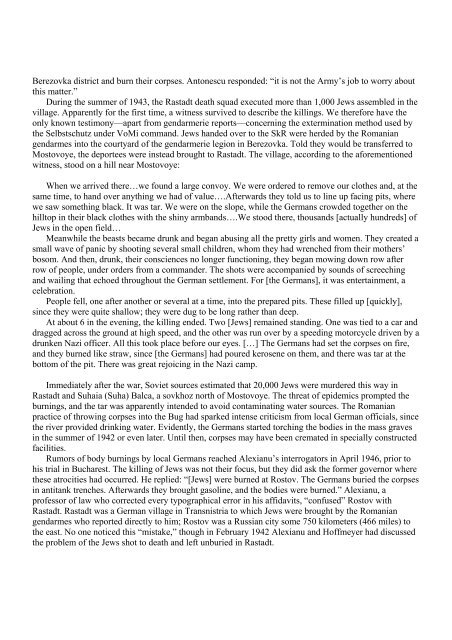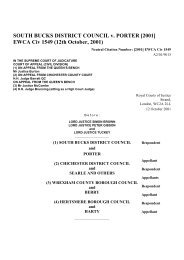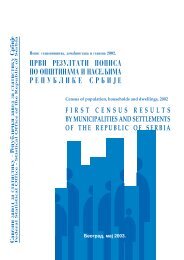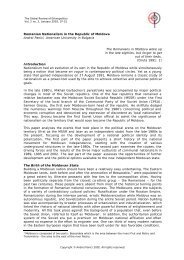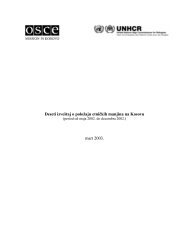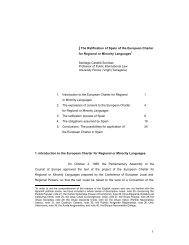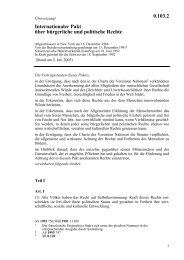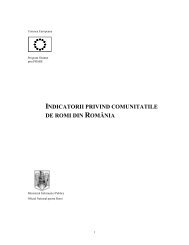Final Report of the International Commission on the - Minority Rights ...
Final Report of the International Commission on the - Minority Rights ...
Final Report of the International Commission on the - Minority Rights ...
You also want an ePaper? Increase the reach of your titles
YUMPU automatically turns print PDFs into web optimized ePapers that Google loves.
Berezovka district and burn <str<strong>on</strong>g>the</str<strong>on</strong>g>ir corpses. Ant<strong>on</strong>escu resp<strong>on</strong>ded: “it is not <str<strong>on</strong>g>the</str<strong>on</strong>g> Army’s job to worry about<br />
this matter.”<br />
During <str<strong>on</strong>g>the</str<strong>on</strong>g> summer <str<strong>on</strong>g>of</str<strong>on</strong>g> 1943, <str<strong>on</strong>g>the</str<strong>on</strong>g> Rastadt death squad executed more than 1,000 Jews assembled in <str<strong>on</strong>g>the</str<strong>on</strong>g><br />
village. Apparently for <str<strong>on</strong>g>the</str<strong>on</strong>g> first time, a witness survived to describe <str<strong>on</strong>g>the</str<strong>on</strong>g> killings. We <str<strong>on</strong>g>the</str<strong>on</strong>g>refore have <str<strong>on</strong>g>the</str<strong>on</strong>g><br />
<strong>on</strong>ly known testim<strong>on</strong>y—apart from gendarmerie reports—c<strong>on</strong>cerning <str<strong>on</strong>g>the</str<strong>on</strong>g> exterminati<strong>on</strong> method used by<br />
<str<strong>on</strong>g>the</str<strong>on</strong>g> Selbstschutz under VoMi command. Jews handed over to <str<strong>on</strong>g>the</str<strong>on</strong>g> SkR were herded by <str<strong>on</strong>g>the</str<strong>on</strong>g> Romanian<br />
gendarmes into <str<strong>on</strong>g>the</str<strong>on</strong>g> courtyard <str<strong>on</strong>g>of</str<strong>on</strong>g> <str<strong>on</strong>g>the</str<strong>on</strong>g> gendarmerie legi<strong>on</strong> in Berezovka. Told <str<strong>on</strong>g>the</str<strong>on</strong>g>y would be transferred to<br />
Mostovoye, <str<strong>on</strong>g>the</str<strong>on</strong>g> deportees were instead brought to Rastadt. The village, according to <str<strong>on</strong>g>the</str<strong>on</strong>g> aforementi<strong>on</strong>ed<br />
witness, stood <strong>on</strong> a hill near Mostovoye:<br />
When we arrived <str<strong>on</strong>g>the</str<strong>on</strong>g>re…we found a large c<strong>on</strong>voy. We were ordered to remove our clo<str<strong>on</strong>g>the</str<strong>on</strong>g>s and, at <str<strong>on</strong>g>the</str<strong>on</strong>g><br />
same time, to hand over anything we had <str<strong>on</strong>g>of</str<strong>on</strong>g> value….Afterwards <str<strong>on</strong>g>the</str<strong>on</strong>g>y told us to line up facing pits, where<br />
we saw something black. It was tar. We were <strong>on</strong> <str<strong>on</strong>g>the</str<strong>on</strong>g> slope, while <str<strong>on</strong>g>the</str<strong>on</strong>g> Germans crowded toge<str<strong>on</strong>g>the</str<strong>on</strong>g>r <strong>on</strong> <str<strong>on</strong>g>the</str<strong>on</strong>g><br />
hilltop in <str<strong>on</strong>g>the</str<strong>on</strong>g>ir black clo<str<strong>on</strong>g>the</str<strong>on</strong>g>s with <str<strong>on</strong>g>the</str<strong>on</strong>g> shiny armbands….We stood <str<strong>on</strong>g>the</str<strong>on</strong>g>re, thousands [actually hundreds] <str<strong>on</strong>g>of</str<strong>on</strong>g><br />
Jews in <str<strong>on</strong>g>the</str<strong>on</strong>g> open field…<br />
Meanwhile <str<strong>on</strong>g>the</str<strong>on</strong>g> beasts became drunk and began abusing all <str<strong>on</strong>g>the</str<strong>on</strong>g> pretty girls and women. They created a<br />
small wave <str<strong>on</strong>g>of</str<strong>on</strong>g> panic by shooting several small children, whom <str<strong>on</strong>g>the</str<strong>on</strong>g>y had wrenched from <str<strong>on</strong>g>the</str<strong>on</strong>g>ir mo<str<strong>on</strong>g>the</str<strong>on</strong>g>rs’<br />
bosom. And <str<strong>on</strong>g>the</str<strong>on</strong>g>n, drunk, <str<strong>on</strong>g>the</str<strong>on</strong>g>ir c<strong>on</strong>sciences no l<strong>on</strong>ger functi<strong>on</strong>ing, <str<strong>on</strong>g>the</str<strong>on</strong>g>y began mowing down row after<br />
row <str<strong>on</strong>g>of</str<strong>on</strong>g> people, under orders from a commander. The shots were accompanied by sounds <str<strong>on</strong>g>of</str<strong>on</strong>g> screeching<br />
and wailing that echoed throughout <str<strong>on</strong>g>the</str<strong>on</strong>g> German settlement. For [<str<strong>on</strong>g>the</str<strong>on</strong>g> Germans], it was entertainment, a<br />
celebrati<strong>on</strong>.<br />
People fell, <strong>on</strong>e after ano<str<strong>on</strong>g>the</str<strong>on</strong>g>r or several at a time, into <str<strong>on</strong>g>the</str<strong>on</strong>g> prepared pits. These filled up [quickly],<br />
since <str<strong>on</strong>g>the</str<strong>on</strong>g>y were quite shallow; <str<strong>on</strong>g>the</str<strong>on</strong>g>y were dug to be l<strong>on</strong>g ra<str<strong>on</strong>g>the</str<strong>on</strong>g>r than deep.<br />
At about 6 in <str<strong>on</strong>g>the</str<strong>on</strong>g> evening, <str<strong>on</strong>g>the</str<strong>on</strong>g> killing ended. Two [Jews] remained standing. One was tied to a car and<br />
dragged across <str<strong>on</strong>g>the</str<strong>on</strong>g> ground at high speed, and <str<strong>on</strong>g>the</str<strong>on</strong>g> o<str<strong>on</strong>g>the</str<strong>on</strong>g>r was run over by a speeding motorcycle driven by a<br />
drunken Nazi <str<strong>on</strong>g>of</str<strong>on</strong>g>ficer. All this took place before our eyes. […] The Germans had set <str<strong>on</strong>g>the</str<strong>on</strong>g> corpses <strong>on</strong> fire,<br />
and <str<strong>on</strong>g>the</str<strong>on</strong>g>y burned like straw, since [<str<strong>on</strong>g>the</str<strong>on</strong>g> Germans] had poured kerosene <strong>on</strong> <str<strong>on</strong>g>the</str<strong>on</strong>g>m, and <str<strong>on</strong>g>the</str<strong>on</strong>g>re was tar at <str<strong>on</strong>g>the</str<strong>on</strong>g><br />
bottom <str<strong>on</strong>g>of</str<strong>on</strong>g> <str<strong>on</strong>g>the</str<strong>on</strong>g> pit. There was great rejoicing in <str<strong>on</strong>g>the</str<strong>on</strong>g> Nazi camp.<br />
Immediately after <str<strong>on</strong>g>the</str<strong>on</strong>g> war, Soviet sources estimated that 20,000 Jews were murdered this way in<br />
Rastadt and Suhaia (Suha) Balca, a sovkhoz north <str<strong>on</strong>g>of</str<strong>on</strong>g> Mostovoye. The threat <str<strong>on</strong>g>of</str<strong>on</strong>g> epidemics prompted <str<strong>on</strong>g>the</str<strong>on</strong>g><br />
burnings, and <str<strong>on</strong>g>the</str<strong>on</strong>g> tar was apparently intended to avoid c<strong>on</strong>taminating water sources. The Romanian<br />
practice <str<strong>on</strong>g>of</str<strong>on</strong>g> throwing corpses into <str<strong>on</strong>g>the</str<strong>on</strong>g> Bug had sparked intense criticism from local German <str<strong>on</strong>g>of</str<strong>on</strong>g>ficials, since<br />
<str<strong>on</strong>g>the</str<strong>on</strong>g> river provided drinking water. Evidently, <str<strong>on</strong>g>the</str<strong>on</strong>g> Germans started torching <str<strong>on</strong>g>the</str<strong>on</strong>g> bodies in <str<strong>on</strong>g>the</str<strong>on</strong>g> mass graves<br />
in <str<strong>on</strong>g>the</str<strong>on</strong>g> summer <str<strong>on</strong>g>of</str<strong>on</strong>g> 1942 or even later. Until <str<strong>on</strong>g>the</str<strong>on</strong>g>n, corpses may have been cremated in specially c<strong>on</strong>structed<br />
facilities.<br />
Rumors <str<strong>on</strong>g>of</str<strong>on</strong>g> body burnings by local Germans reached Alexianu’s interrogators in April 1946, prior to<br />
his trial in Bucharest. The killing <str<strong>on</strong>g>of</str<strong>on</strong>g> Jews was not <str<strong>on</strong>g>the</str<strong>on</strong>g>ir focus, but <str<strong>on</strong>g>the</str<strong>on</strong>g>y did ask <str<strong>on</strong>g>the</str<strong>on</strong>g> former governor where<br />
<str<strong>on</strong>g>the</str<strong>on</strong>g>se atrocities had occurred. He replied: “[Jews] were burned at Rostov. The Germans buried <str<strong>on</strong>g>the</str<strong>on</strong>g> corpses<br />
in antitank trenches. Afterwards <str<strong>on</strong>g>the</str<strong>on</strong>g>y brought gasoline, and <str<strong>on</strong>g>the</str<strong>on</strong>g> bodies were burned.” Alexianu, a<br />
pr<str<strong>on</strong>g>of</str<strong>on</strong>g>essor <str<strong>on</strong>g>of</str<strong>on</strong>g> law who corrected every typographical error in his affidavits, “c<strong>on</strong>fused” Rostov with<br />
Rastadt. Rastadt was a German village in Transnistria to which Jews were brought by <str<strong>on</strong>g>the</str<strong>on</strong>g> Romanian<br />
gendarmes who reported directly to him; Rostov was a Russian city some 750 kilometers (466 miles) to<br />
<str<strong>on</strong>g>the</str<strong>on</strong>g> east. No <strong>on</strong>e noticed this “mistake,” though in February 1942 Alexianu and H<str<strong>on</strong>g>of</str<strong>on</strong>g>fmeyer had discussed<br />
<str<strong>on</strong>g>the</str<strong>on</strong>g> problem <str<strong>on</strong>g>of</str<strong>on</strong>g> <str<strong>on</strong>g>the</str<strong>on</strong>g> Jews shot to death and left unburied in Rastadt.


